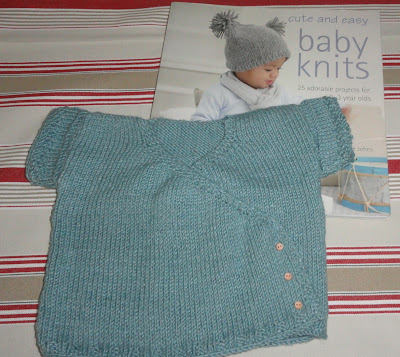I'm sure it is no surprise to most of you to know I took knitting with me when I went to the Blue Mountains. There is nothing quite like a knitting project and a book in your bag when you travel. Either of them will get your through long train trips, very talkative fellow travellers, and those moments of boredom when you feel you can sit still no longer. Both of them combined make a long journey treasured time to create and reflect. I am knitting with Vivian's beautiful yarns from Eco Yarns now and every time I pick up the needles and feel the quality of the organic cotton she sent, I fall in love with knitting all over again. I am knitting for my grandson Jamie at the moment so only the best will do. While I was away I finished a pure cotton kimono top for him. It will be soft on his delicate skin and I won't be concerned about introducing him to any harmful chemicals in the yarn or dye because I know it is organic, whisper soft and completely safe. I used the pattern in this Cute and Easy Baby Knits book and a fine set of Clover bamboo needles.
Baby clothes need frequent washing so using quality yarn that will stand up to all that washing is essential. When you knit something as a gift, it is a very good idea to include some information about the yarn and how to care for it. I always give washing instructions for that particular yarn to the person who will do the washing, in this case, Jamie's wonderful mum, Sunny. It makes the task easier and will keep the garment wearable for many long years, and possibly for other babies who come along.
This is the label from the cotton used in the kimono top. I'll pin it to the top when I give it to Sunny and hope that she reads this post on caring for cotton. She usally reads the blog, so she may have already seen the top and read the instructions before I give it to her. Hello Sunny!
I believe hand washing is best for this type of garment.
HAND WASHING COTTON OR WOOL
Fill an enamel dish or plastic bucket with warm water. Don't use hot water because untreated organic cotton can shrink in heat. There are chemicals in ordinary cotton to stop shrinkage.
Place the garment in the water and completely soak it. Add either homemade liquid soap or bar soap, or dissolved Lux flakes and move the garment through the water gently squeezing it while it's under the water to allow the warm water to swish through the fibres. Natural fibres are much better washed with pure soap than anything else, and handwash if you can, the washing machine will weaken the fibres over time.
When you know the garment is clean, pour the water down the sink and fill the basin with clean water for rinsing. Never wring out natural fibres - it will stretch and weaken them. When the garment is thoroughly rinsed (at least two changes of water), squeeze as much water as possible out of it(without wringing), support it with both hands and place it on a clean dry towel. Roll it in the towel into a cigar shape, and press down to remove the water again. Do this a couple of times and replace the towel if it gets too wet. When most of the water is gone, lay the garment on a clean dry towel in the shade and allow to dry. Do not hang the garment because it will stretch. I have to admit, I like the ritual of hand washing special items of clothing - it's like paying respect to something special. I know many of you don't have the time for such things though so ...
Alternatively, when the garment has been hand washed, you can use the gentle spin cycle on your washing machine to remove most of the water. When it's finished spinning, place it flat on a towel and place in the shade to dry.
TREATING FOOD STAINS
If there is a food spill, remove the garment and treat it before the stain dries. If there are dry stains on the garment, plunge it into a basin of cold/warm water, apply soap to the stain and rub gently. If this doesn't remove the stain, add the garment to a half bucket of warm water with a lid full of powdered oxygen bleach added. Leave overnight and wash as above. This bleach is peroxide-based, not chlorine, so it won't harm the fibres.
The day after I finished Jamie's top, I started a new project, this time using Vivian's baby alpaca (see above). I'm knitting a rolled edge beanie from the Simple Knits for Cherished Babies book. It will be a soft and cosy winter hat for Jamie. When I've finished that, I'll start on a few things for our other grandson who be be along soon - in mid July. I always think it's impossible, but life keeps getting better.



